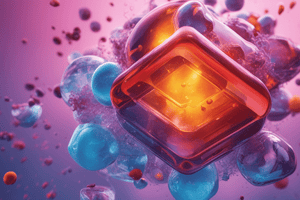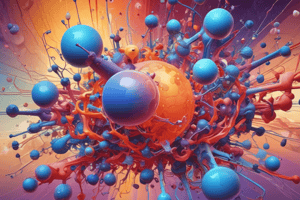Podcast
Questions and Answers
How does temperature affect the freezing of a substance?
How does temperature affect the freezing of a substance?
- Temperature has no effect on the freezing of a substance.
- As temperature increases, heat loss decreases, lowering the melting point.
- As temperature decreases, the rate of heat loss increases, lowering the melting point. (correct)
- As temperature decreases, the rate of heat loss decreases, increasing the melting point.
What physical properties do solids possess?
What physical properties do solids possess?
- They flow freely and easily change shape.
- They have high viscosity and can easily move past each other.
- Their particles have high kinetic energy.
- They have fixed shapes and well-defined crystal structures. (correct)
Which state of matter has lower viscosity than gases but higher viscosity than solids?
Which state of matter has lower viscosity than gases but higher viscosity than solids?
- Plasma
- Liquid (correct)
- Gas
- Solid
How does pressure affect the melting point of a substance?
How does pressure affect the melting point of a substance?
What is a common factor affecting the transition from liquid to solid state?
What is a common factor affecting the transition from liquid to solid state?
What is the primary factor influencing the transition from solid to liquid?
What is the primary factor influencing the transition from solid to liquid?
In the gaseous state, what allows individual particles to overcome attractive forces and expand infinitely?
In the gaseous state, what allows individual particles to overcome attractive forces and expand infinitely?
What primarily influences the change from solid to gas (sublimation)?
What primarily influences the change from solid to gas (sublimation)?
What is a notable property of plasmas according to the text?
What is a notable property of plasmas according to the text?
What happens as the temperature increases for the transition from gas to plasma?
What happens as the temperature increases for the transition from gas to plasma?
Flashcards are hidden until you start studying
Study Notes
Changes in States of Matter
States of matter describe the physical properties of substances, such as solid, liquid, gas, plasma, and Bose-Einstein condensates. Understanding these changes is crucial because they help us explain how a substance behaves under different temperature and pressure conditions. In this article, we will explore the different stages of matter and the factors influencing transitions between them.
Solid State
Atoms or molecules in solids vibrate around their equilibrium positions, leading to strong intermolecular forces. This results in fixed shapes and well-defined crystal structures within the solid. Metals, ceramics, and ice are examples of materials in the solid state.
Factors Affecting Transition from Liquid to Solid (Freezing)
Factors affecting freezing include temperature, pressure, volume, and the nature of the substance being cooled. Some common factors and their effects on freezing are:
- Temperature: As temperature decreases, the rate of heat loss increases, causing more thermal energy to be lost and lowering the melting point of the substance.
- Pressure: At higher pressures, the melting point of a substance generally increases due to increased packing density and stronger molecular interactions.
Liquid State
Liquids have lower viscosity than gases but higher viscosity than solids. They flow freely when subjected to gravity, making it easier for molecules to move past each other. Examples include water, alcohol, and oils.
Factors Affecting Transition from Solid to Liquid (Melting)
The primary factors influencing the transition from solid to liquid (melting) are temperature, pressure, and changes in the internal structure of the substance being heated. Common factors and their effects on melting include:
- Temperature: When heat is added, the kinetic energy of particles increases, eventually reaching a critical value where the weak bonds between particles break, causing the material to melt.
- Pressure: At constant temperature, increasing pressure can force atoms closer together, increasing the likelihood of breaking weak interatomic bonds, which leads to melting.
Gas State
In the gaseous state, individual particles gain enough thermal energy to overcome attractive forces among themselves and with surrounding surfaces. Gases expand infinitely until stopped by a barrier, like a container wall. Hydrogen, helium, oxygen, nitrogen, carbon dioxide, chlorine, ammonia, methane, and many other elements and compounds exist as gases, especially at room temperatures and atmospheric pressure.
Factors Affecting Transition from Solid to Gas (Sublimation)
Factors influencing the change from solid to gas mainly involve temperature and pressure changes. Key factors and their effects on sublimation include:
- Temperature: Elevating temperature causes particles to gain thermal energy, allowing them to surpass the activation energy required to escape into the vapor phase.
- Pressure: Sublimation occurs most rapidly at low ambient pressure.
Plasma State
Plasmas exhibit both fluidic flow properties like liquids and ionized particles like solids or gases. They are formed when a portion of gas or liquid becomes charged due to loss or addition of electrons to atoms or molecules. Examples of plasmas include lightning bolts during thunderstorms and fluorescent light bulbs.
Factors Affecting Transition from Gas to Plasma
Factors affecting the transition from gas to plasma primarily involve temperature and pressure changes, along with energy input:
- Temperature: As temperature increases, more thermal energy is available for electrons to overcome their binding energies with neutral atoms, causing them to become free.
- Pressure: Increasing pressure encourages collisions between particles, increasing the likelihood that an electron will gain sufficient velocity to escape and form a plasma.
Bose-Einstein Condensates
Bose-Einstein condensates (BECs) arise when a group of bosons—particles without half-integer spin—occupy the same quantum state, resembling a single particle in terms of macroscopic properties. These states of matter exhibit unique phenomena, such as superfluidity and quantum turbulence, making them exceptional tools for fundamental physics investigations.
Factors Affecting Transition into Bose-Einstein Condensates
The factors influencing the formation of BECs primarily depend on temperature and pressure changes, along with specific conditions related to the atomic interactions and particle density within a system:
- Temperature: Lower temperatures reduce thermal motion among particles, allowing them to occupy lower-energy, degenerate energy levels, leading to BEC formation.
- External Pressure: High external pressure can increase particle densities in a system, enhancing the chances of particles entering the low-energy ground state required for BEC formation.
In summary, understanding changes in states of matter is essential for explaining the behavior of substances under varying temperature and pressure conditions. By examining the factors influencing transitions between solid, liquid, gas, plasma, and Bose-Einstein condensates, we can gain insights into the unique properties and behaviors of these states of matter.
Studying That Suits You
Use AI to generate personalized quizzes and flashcards to suit your learning preferences.




